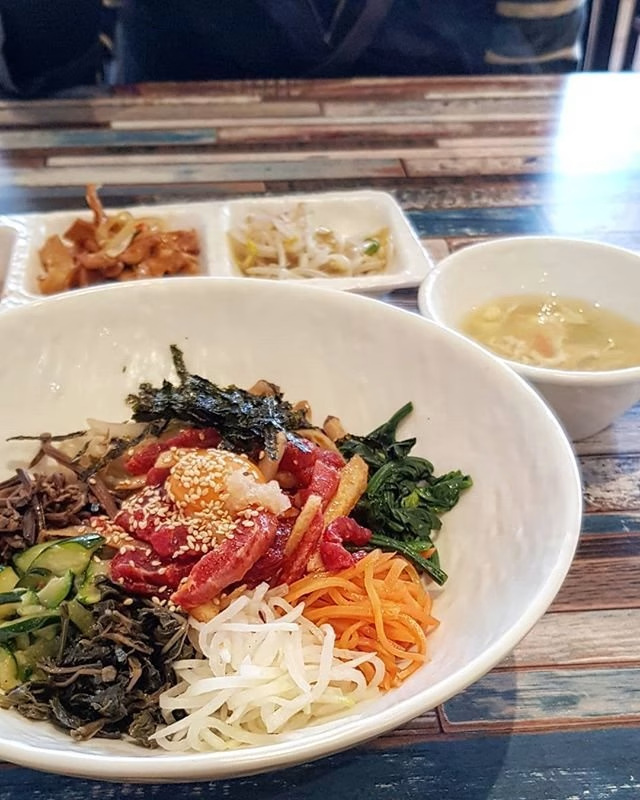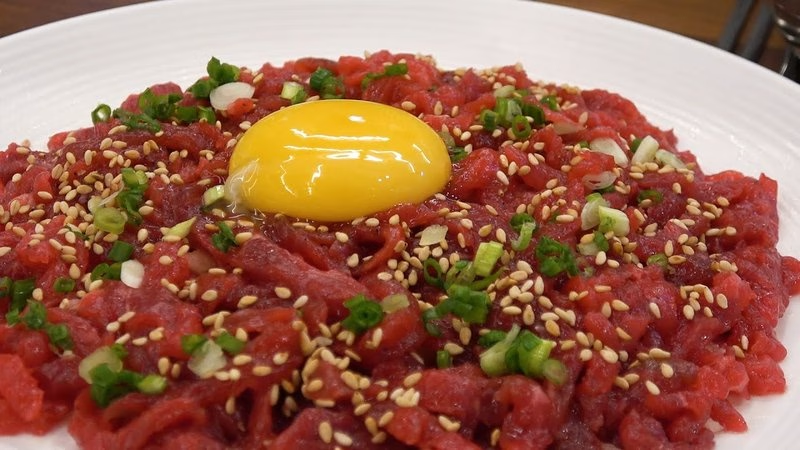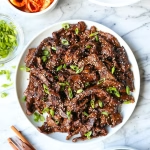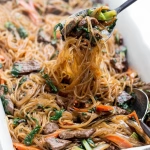
Welcome to the vibrant world of Yukhoe Bibimbap! This delightful dish is a Korean favorite, combining marinated raw beef, fresh vegetables, and perfectly cooked rice, all topped with a rich soy sauce or sesame dressing. Known for its unique flavors and colorful presentation, Yukhoe Bibimbap isn’t just a meal; it’s an experience steeped in tradition. This dish offers a beautiful blend of textures and tastes, from the tender beef to the crisp veggies, making it one of the standout meals in Korean cuisine.
In this article, you’ll discover how to create authentic Yukhoe Bibimbap at home using simple ingredients. I’ll guide you through the necessary preparations, cooking steps, and even some pro tips to elevate your dish. By the end, you’ll be ready to impress friends and family with your culinary skills while enjoying a taste of Korea right in your kitchen!
Ingredients
| Ingredient | Measurement | Description |
|---|---|---|
| Thinly sliced beef | 200g | Fresh, high-quality beef is the star of Yukhoe Bibimbap, providing a tender and juicy base. |
| Cooked white rice | 1 cup | Soft, fluffy rice complements the flavors and acts as a filling base for the dish. |
| Carrot | 1 medium, julienned | Adding a sweet crunch, carrots provide both color and nutrition to your Yukhoe Bibimbap. |
| Cucumber | 1 medium, julienned | Refreshing and crisp, cucumbers lighten the dish and add a lovely crunch. |
| Egg yolk | 1 | A rich egg yolk can be added on top for creaminess, balancing the spiciness of the sauce. |
| Sesame oil | 1 tablespoon | Brings depth and nuttiness to the dish, enhancing the umami flavor profile. |
| Yukhoe Bibimbap sauce | to taste | A homemade soy-based sauce with a hint of sweetness and spice is essential for authentic flavor. |
Step-by-Step Instructions
- Step 1: Prepare the Ingredients – Start by gathering all your ingredients. Ensure the beef is fresh and thinly sliced. Julienne the carrots and cucumbers, and set aside.
- Step 2: Marinate the Beef – In a bowl, combine the sliced beef with sesame oil, a splash of Yukhoe Bibimbap sauce, and a sprinkle of sesame seeds. Mix well and let it marinate for about 15 minutes to absorb all those amazing flavors.
- Step 3: Cook the Rice – Rinse and cook your white rice using a rice cooker or stovetop method. The rice should be fluffy and warm when ready to serve.
- Step 4: Assemble the Dish – In a large bowl, place a serving of warm cooked rice at the bottom. Arrange the marinated beef, cucumbers, and carrots beautifully on top of the rice.
- Step 5: Add the Egg Yolk – Delicately place the raw egg yolk in the center of the bowl, allowing it to ooze into the other ingredients when mixed.
- Step 6: Drizzle the Sauce – Pour more Yukhoe Bibimbap sauce over the top to enhance the flavor. You can adjust the amount based on your spice preference.
- Step 7: Serve and Enjoy – Mix everything together and savor the delightful flavors of your freshly made Yukhoe Bibimbap. Enjoy it with some kimchi or pickled vegetables on the side!
Pro Tips
- Choose Quality Meat: Always opt for high-quality, fresh beef for the best flavor and texture. Look for cuts like sirloin or filet mignon.
- Customize Your Veggies: Feel free to add other vegetables such as radishes, spinach, or seaweed for variety. The more colorful, the better!
- Make it Spicy: If you enjoy some heat, add gochujang (Korean chili paste) to your sauce for a spicy kick.
- Serving Temperature: Serve your Yukhoe Bibimbap immediately after assembly to ensure the rice is warm and the flavors are vibrant.
- Leftover Beef: If you have leftovers, consider making a stir-fry the next day to use up the marinated meat!
Nutritional Information
| Nutrient | Per Serving |
|---|---|
| Calories | 500 |
| Protein | 30g |
| Carbohydrates | 60g |
| Saturated Fats | 5g |
| Fiber | 4g |
| Cholesterol | 120mg |
| Sugars | 6g |
| Total Fats | 18g |
FAQs
What is the best way to store Yukhoe Bibimbap?
Store leftover Yukhoe Bibimbap in an airtight container in the fridge. For the best texture, separate the rice and vegetables from the beef.
Can Yukhoe Bibimbap be made vegan or gluten-free?
Yes! Substitute the beef with marinated tofu or mushrooms. Use gluten-free soy sauce to keep it gluten-free.
What are the best side dishes to serve with Yukhoe Bibimbap?
Kimchi, pickled radishes, or a simple cucumber salad pair beautifully with Yukhoe Bibimbap.
How long does it take to prepare Yukhoe Bibimbap?
Preparation and cooking take approximately 30-45 minutes, depending on your efficiency in chopping and marinating.
Can I freeze Yukhoe Bibimbap for later?
Freezing is not recommended due to the raw meat. However, you can freeze the rice or vegetables separately and combine them when you’re ready to eat.
What’s the origin of Yukhoe Bibimbap?
Yukhoe Bibimbap originated in Korea, where raw meat dishes are common. It’s a traditional meal often enjoyed during festive occasions.
Is Yukhoe Bibimbap spicy?
The spiciness depends on the type and amount of Yukhoe Bibimbap sauce used. Adjust according to your preference!
Can I add more toppings to Yukhoe Bibimbap?
Absolutely! Feel free to experiment with toppings like seaweed, sprouts, or even fruits for a unique flavor twist.
In conclusion, making delicious Yukhoe Bibimbap at home is not only achievable but also incredibly rewarding. With its vibrant colors, fresh ingredients, and unique flavors, this dish is sure to become a favorite in your household. So why not step into your kitchen and give it a try? I hope you find joy in creating this traditional Korean dish and that it brings smiles to your table.
Tried this Yukhoe Bibimbap recipe? Let us know your experience in the comments below! Happy cooking!






